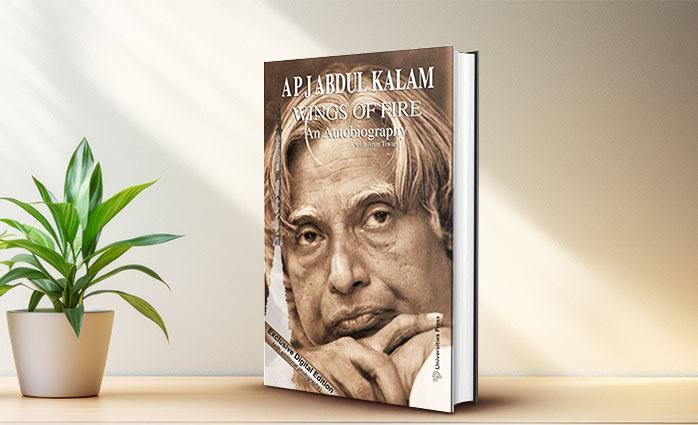Introduction
Wings of Fire is the autobiography of the former President of India, Dr. Abdul Kalam. Kalam went from being a humble boy in South India to developing India’s nuclear weapons and becoming President. Through this autobiography, the reader gains a glimpse into pre-partition India. Kalam also exposes readers to the positive thinking and ideas that helped him become such a success. This is the story of Kalam’s rise from obscurity and his personal and professional struggles. It is also a saga of independent India’s struggle for technological self-sufficiency and defensive autonomy.
Kalam’s Upbringing
Kalam starts the book at the beginning of his life. He was born in Rameswaram, India, to a secure middle-class Tamil family. His father owned a boat, which is a sign of wealth. Rameswaram was a great environment to grow up in, as there was a tight-knit community where everybody supported each other. People were willing to talk about religion and spirituality openly. From a young age, Kalam developed a respect for other religions. His father also worked as an Imam in the local mosque. Kalam grew up believing that faith is an essential part of being human.
All family members encouraged Kalam to work hard and excel at school. Kalam’s family talked a lot about the latest scientific advancements and new groundbreaking literature over dinner. These conversations formed a foundation for the passion for academia that Kalam developed. Kalam was close to his parents and described his mother as more like a friend than a parent. He also introduces the readers to his closest friend, Ahmed Jalaluddin. Kalam developed intellectual and spiritual maturity from a young age because Ahmed was about 15 years older. They frequently visited the mosque together and talked about Islam.
You Should Read: Abdul Kalam: Missile Man of India
Learning Difficulty at High School
To fulfill his dream of learning about the most advanced technology and science, Kalam left his hometown to attend Schwartz High School in Ramanathapuram. At first, Kalam thoroughly enjoyed his time at school. However, one day a new teacher arrived. This teacher, called Rameswaram Shastry, saw Kalam sitting next to a Hindu student. He told Kalam that this was not allowed and decided to send Kalam to the back of the class.
This was an early example of the beliefs people held during the partition of India. After this experience, Kalam decided to stop the poison of prejudice from spreading, rather than spreading it himself. He continued to be open to all religions throughout his life, including during and after India’s partition.
When Kalam was a young boy, he sold newspapers to help his brother reduce their financial struggles. In the book, Kalam praises the demands and support of friends and family as the cornerstone of his life’s successes.
Kalam’s Experiences With Engineering
Kalam continued to excel throughout high school and remained particularly interested in science. After completing the B.Sc. in physics, Abdul Kalam noticed that he needed to engage with engineering to make his dreams a reality. So, he chose to apply for an engineering course at the Madras Institute of Technology. That said, despite coming from a relatively wealthy background, the admission fees were still too expensive for him. Luckily, his eldest sister saw his potential and was willing to help him obtain a place. She supported him financially throughout the early stages of his time at the Madras Institute of Technology.
Learning to Fly
This generosity encouraged Kalam to work as hard as possible to obtain a scholarship. His hard work eventually paid off, and he took some financial burdens off his elder sister. As well as academic success, Kalam was working towards living his dream. He had always dreamed of flying an aircraft. So, it makes perfect sense that Kalam decided to choose aeronautical engineering as his major at university.
Kalam provides advice to future engineering students. Specifically, he says, ‘When they choose their specialization, the essential point to consider is whether the choice articulates their inner feelings and aspirations.’ Kalam decided to pursue aeronautical engineering because it aligned with his passions. Kalam suggests that future engineers, and all future professionals, should choose a role that aligns with their dreams. This is the most critical factor.
Looking for Work
After graduating from university, Kalam had to choose between two passions. His first option was to join the Air Force. His second option was to seek a job at the Directorate of Technical Development and Production. Essentially, the latter would involve working for India’s Ministry of Defence. Kalam applied for the Air Force to achieve his dream of flying, but he was ultimately rejected.
Kalam was initially deflated. Deeply disappointed, he trekked down to nearby Rishikesh, where he met Swami Sivananda, a spiritual teacher, author, and yoga guru. Kalam considers this meeting to be one of the most important events in his life. Sivananda taught him that he had to accept his destiny and go ahead with his life. It is not worth mulling over things in the past. Instead, Kalam was better off moving forward. This is exactly what Kalam did. He could still use his passion for aeronautical engineering by working for the Directorate of Technical Development and Production as a Senior Scientific Assistant.
Kalam’s Destiny Changes
Although Kalam’s design, Nandi, was initially rejected, this was not the end of its story. The design had already created interest and buzz. Then, as if destiny came knocking, the Indian committee for Space Research invited Kalam for an interview.
They were going to interview him for the post of Rocket Engineer. In this interview, he met Prof. Sarabhai, the father of the Indian Space Program. Kalam got the job and spent many years working as a Rocket Engineer. So, a large proportion of this part of the book is educational. Kalam outlines the different space stations and organizations based within India. After his initial setback, Kalam excelled in rocket science.
He received the Padma Bhushan award after SLV-3, one of his rockets, was successfully launched. The Padma Bhushan is the second-highest civilian award of the Republic of India. He then moved to rocketry at the Defence Research and Development Organization. Kalam successfully introduced the Integrated Guided Missile Development Program for the development of five different missiles. On the successful launch of India’s missile program, Kalam received the Padma Vibhushan. Kalam thinks failures are seeds for learning and believes India could be a technological leader despite repeated failures.
The Three Mighty Forces
To succeed in life and achieve results, you must achieve and understand three mighty forces:
- Desire
- Belief
- Expectations
These were the most important forces driving Kalam towards success. He wanted to make a difference in India through science and technology. Kalam also believed in his ability and in God to guide him towards these desires. This belief was strong and was not swayed by setbacks, such as when he was rejected from the Air Force. Instead of giving up, Kalam accepted that his life was just guiding him towards a different and more complementary path. Finally, Kalam explains that you need to have expectations for your life. Expectations allow you to set goals and react accordingly. Without expectations, you will not have any success or failure. Importantly, expectations allow you to identify failure and learn from these experiences.
Kalam’s Death
Although not covered in this book, Kalam’s death follows the type of person he was. Specifically, Kalam passed away due to cardiac arrest while giving a speech to scientific students. He committed his life to advancing India’s scientific and technological understanding.


I really enjoy looking at on this website , it has good blog posts.
thanks